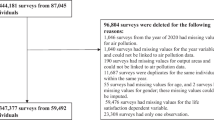Abstract
The purpose of this paper is to investigate the influence of objective air quality on individual life satisfaction (LS) through the moderating effect of perceived air quality on the latter. Unlike previous studies, we incorporates both of the data from the 2010 Taiwan Social Change Survey and the monthly mean of Pollutant Standards Index (PSI) from fixed air quality monitoring stations to understand their association with individual well-being. A two-stage estimation approach is employed, in which individual perceived subjective air quality level is employed as an explanatory variable in LS regression models. The results show that the objective measure of air quality, PSI, is significantly associated with the perceived air quality and with LS, respectively. When the endogeneity of perceived air quality is considered in the relationship between objective air quality and life satisfaction, the results indicate that the perceived air quality has a positive influence on LS, while the effect of objective measure of air quality on the latter becomes insignificant. In sum, the objective air quality has an indirect effect, but no direct effect, on LS. Furthermore, individual’s age, gender, health, and variables of environmental experience and behaviors are found to be significant determinants of LS. Discussions on the findings are provided.

Similar content being viewed by others
Notes
There exists the known causal relationships between objective indicators of air quality, health status, and life satisfaction. However, the relationship between health status and objective air quality is weak and ambiguous.
PM10 refers to a particle with a diameter of 10 micrometers or less. Sources of particle matter can be dust on the street, the burning of fossil fuels in vehicles, open combustion, construction works, and agricultural plowing. If other pollutants adhere to those particles, they will reinforce harmfulness to the respiratory system. Sulfur dioxide (SO2) is mainly generated from the combustion of petroleum or coal. It is a colorless gas with a penetrating odor, and easily dissolves in water to form sulfurous acid. It can oxidize to the sulfate in the air that is the main substance that causes acid rain. Nitrogen dioxide is a kind of red-brown gas with a stimulative smell, and easily dissolves in water to form nitrous acid and nitric acid. The oxidization of nitrate is one of the factors causing acid rain. Ozone is one kind of secondary pollutant that is generated by nitrogen oxides or reactive hydrocarbons after they are activated by the sunlight. It is a highly active oxidization gas, and stimulative to the respiratory system in that it will cause coughing, asthma, headaches, weariness, and lung injuries, especially affecting children, the old, patients, and those exercising outdoors. Carbon monoxide is generated by the incomplete combustion of petrochemical fuels. It is colorless, smell-less and lighter than air.
References
Allison, P. D. (2001). Missing data. Thousand Oaks, CA: Sage Publications.
Andrews, F. M., & Withey, S. B. (1976). Social indicators of well-being: Americans’ perceptions of life quality. New York: Plenum Press.
Argyle, M. (1997). Is happiness a cause of health? Psychology and Health, 12, 769–781.
Bardo, J. W., & Bardo, D. J. (1983). A re-examination of subjective components of community satisfaction in a British new town. Journal of Social Psychology, 120, 35–43.
Blanchflower, D. G., & Oswald, A. J. (2004). Well-being over time in Britain and the USA. Journal of Public Economics, 88, 1359–1386.
Brown, R. B. (1993). Rural community satisfaction and attachment in mass consumer society. Rural Sociology, 58(3), 387–403.
Campbell, A. (1981). The sense of well-being in America. New York: McGraw-Hill.
Campbell, A., Converse, P. E., & Rodgers, W. L. (1976). The perceived quality of life and its implications. In A. Campbell, P. E. Converse, & W. L. Rodgers (Eds.), The quality of American life (pp. 471–508). New York: Russell Sage Foundation Press.
Chamberlain, K. (1985). Value dimensions cultural differences and the prediction of perceived quality of life. Social Indicators Research, 17, 345–401.
Chang, Y. H., Tu S. H., & Liao P.S., (2012). 2010 Taiwan Social Change Survey (Round 6, Year 1): Environment (C00221_2) [Data file]. Available from Survey Research Data Archive, Center for Survey Research, Research Center for Humanities and Social Sciences, Academia Sinica. doi:10.6141/TW-SRDA-C00221_2-1.
Diener, E., & Lucas, R. E. (2000). Explaining differences in societal levels of happiness: Relative standards, need fulfillment, culture, and evaluation theory. Journal of Happiness Studies, 1, 41–78.
Emmons, R. A., & Diener, E. (1985). Factors predicting satisfaction judgment: A comparative examination. Social Indicator Research, 16, 157–167.
Falkenberg, A. W. (1998). Quality of life efficiency, equity and freedom in the United States and Scandinavia. Journal of Socio-Economics, 27(1), 1–27.
Ferreira, S., & Moro, M. (2010). On the use of subjective well-being data for environmental valuation. Environmental & Resource Economics, 46, 249–273.
Ferrer-i-Carbonell, A., & Gowdy, J. M. (2007). Environmental degradation and happiness. Ecological Economics, 60, 509–516.
Flint, C. G., & Luloff, A. E. (2005). Natural resource-based communities, risk, and disaster: An intersection of theories. Society and Natural Resources, 18, 399–412.
Hagerty, M. R. (1999). Unifying livability and comparison theory: Cross-national time-series analysis of life-satisfaction. Social Indicators Research, 47, 343–356.
Hagerty, M. R. (2000). Social comparisons of income in one’s community: Evidence from national surveys of incomes and happiness. Journal of Personality and Social Psychology, 78, 764–771.
Hagerty, M. R., Cummins, R. A., Ferriss, A. L., Land, K., Michalos, A. C., Peterson, M., et al. (2001). Quality of life indexes for national policy: Review and agenda for research. Social Indicators Research, 55, 1–96.
Kao, C. H. C., & Liu, B. C. (1984). Socioeconomic advance in the Republic of China (Taiwan): An intertemporal analysis of its quality of life indicators. American Journal of Economics and Sociology, 43(4), 399–412.
Kent, S. H., & Wu, S. Y. (2014). Living happily ever after? The effect of Taiwan’s National Health Insurance on the happiness of the elderly. Journal of Happiness Studies, 15, 783–808.
Land, K. (1983). Social indicators. Annual Review of Sociology, 9, 1–26.
Layard, R. (2005). Happiness: Lessons from the new science. New York: The Penguin Press.
Lewis, S., & Lyon, L. (1986). The quality of community and the quality of life. Sociological Spectrum, 6, 397–410.
Liao, P. S. (2009). Parallels between objective indicators and subjective perceptions of quality of life: A study of metropolitan and county areas in Taiwan. Social Indicators Research, 91(1), 99–114.
Liao, P. S., Fu, Y. C., & Yi, C. C. (2005). Perceived quality of life in Taiwan and Hong Kong: An intraculture comparison. Journal of Happiness Studies, 6, 43–67.
Lu, L. (1999). Personal or environmental causes of happiness: A longitudinal analysis. Journal of Social Psychology, 139, 79–90.
Lu, L. (2001). Understanding happiness: A look into the Chinese folk psychology. Journal of Happiness Studies, 2, 407–432.
Lu, L., & Shih, J. B. (1997). Sources of happiness: A qualitative approach. Journal of Social Psychology, 137, 181–187.
Luechinger, S. (2009). Valuing air quality using the life satisfaction approach. Economic Journal, 119, 482–515.
Luechinger, S. (2010). Life satisfaction and transboundary air pollution. Economics Letter, 107, 4–6.
MacKerron, G., & Mourato, S. (2009). Life satisfaction and air quality in London. Ecological Economics, 68, 1441–1453.
Maddala, G. S. (1983). Limited-dependent and qualitative variables in econometrics. New York: Cambridge University Press.
Martin, J. K., & Lichter, D. T. (1983). Geographic mobility and satisfaction with life and work. Social Science Quarterly, 64, 524–535.
Mastekaasa, A., & Moum, T. (1984). The perceived quality of life in Norway: Regional variations and contextual effects. Social Indicators Research, 14, 385–419.
Menz, T. (2011). Do people habituate to air pollution? Evidence from international life satisfaction data. Ecological Economics, 71, 211–219.
Michalos, A. C., Hubley, A. M., Zumbo, B. D., & Hemingway, D. (2001). Health and other aspects of the quality of life of older people. Social Indicators Research, 54, 239–274.
Michalos, A. C., Zumbo, B. D., & Hubley, A. (2000). Health and the quality of life. Social Indicators Research, 51, 245–286.
Ng, Y. K. (2011). Consumption tradeoff vs. catastrophes avoidance: Implications of some recent results in happiness studies on the economics of climate change. Climate Change, 105, 109–127.
Oliver, P. (1984). If you don’t do it, nobody else will’: Active and token contributors to local collective action. American Sociological Review, 49, 601–610.
Oppong, J. R., Ironside, R. G., & Kennedy, L. W. (1988). Perceived quality of life in a centre-periphery framework. Social Indicators Research, 20, 605–620.
Oswald, A. J. (1997). Happiness and economic performance. Economic Journal, 107, 1815–1831.
Popenoe, D. (1983). Urban scale and the quality of community life: A Swedish community comparison. Sociological Inquiry, 53, 404–418.
Rehdanz, K., & Maddison, D. (2005). Climate and happiness. Ecological Economics, 52, 111–125.
Rehdanz, K., & Maddison, D. (2008). Local environmental quality and life-satisfaction in Germany. Ecological Economics, 64, 787–797.
Schuessler, K. F., & Fisher, G. A. (1985). Quality of life research and sociology. Annual Review of Sociology, 11, 129–149.
Sirgy, M., Joseph, R. N., Widgery, D., Lee, D. J., & Grace, B. Y. (2010). Developing a measure of community well-being based on perceptions of impact in various life domains. Social Indicator Research, 96, 295–311.
Tao, H. L. (2005). The effects of income and children on marital happiness—evidence from middle- and old-aged couples. Applied Economics Letters, 12, 521–524.
Tepperman, L., & Curtis, J. (1995). A life satisfaction scale for use with national adult samples from the USA, Canada and Mexico. Social Indicator Research, 35, 255–270.
Thoits, P. A., & Hewitt, L. N. (2001). Volunteer work and well-being. Journal of Health and Behavior, 42, 115–131.
Tsou, M., & Liu, J. (2001). Happiness and domain satisfaction in Taiwan. Journal of Happiness Studies, 2, 269–288.
Tsui, H. (2014). Income and happiness: The effect of absolute income, relative income and expected income. Journal of Policy Modeling (forthcoming).
Van Praag, B., & Baarsma, B. (2005). Using happiness surveys to value intangibles: The case of airport noise. Economic Journal, 115, 224–246.
Veenhoven, R. (1995). The cross-national pattern of happiness: Test of predictions implied in three theories of happiness. Social Indicators Research, 34, 33–68.
Veenhoven, R. (1996). Developments in satisfaction research. Social Indicators Research, 37, 1–45.
Welsch, H. (2006). Environment and happiness: Valuation of air pollution using life satisfaction data. Ecological Economics, 58, 801–813.
Wilkening, E. A. (1982). Subjective indicators and the quality of life. In R. M. Hauser, D. Mechanic, A. O. Haller, & T. S. Hauser (Eds.), Social structure and behavior (pp. 429–441). New York: Academic Press.
Ziegler, J. A., & Britton, C. R. (1981). A comparative analysis of socioeconomic variations in measuring the quality of life. Social Science Quarterly, 62, 303–312.
Zinam, O. (1989). Quality of life, quality of the individual, technology and economic development. American Journal of Economics and Sociology, 48, 55–68.
Author information
Authors and Affiliations
Corresponding author
Rights and permissions
About this article
Cite this article
Liao, Ps., Shaw, D. & Lin, Ym. Environmental Quality and Life Satisfaction: Subjective Versus Objective Measures of Air Quality. Soc Indic Res 124, 599–616 (2015). https://doi.org/10.1007/s11205-014-0799-z
Accepted:
Published:
Issue Date:
DOI: https://doi.org/10.1007/s11205-014-0799-z




